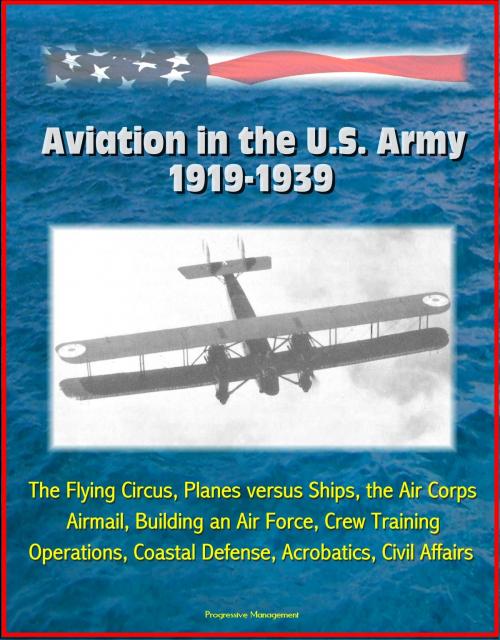Aviation in the U.S. Army, 1919-1939: The Flying Circus, Planes versus Ships, the Air Corps, Airmail, Building an Air Force, Crew Training, Operations, Coastal Defense, Acrobatics, Civil Affairs
Nonfiction, Science & Nature, Technology, Aeronautics & Astronautics, History, Military, Aviation| Author: | Progressive Management | ISBN: | 9781301154173 |
| Publisher: | Progressive Management | Publication: | February 11, 2013 |
| Imprint: | Smashwords Edition | Language: | English |
| Author: | Progressive Management |
| ISBN: | 9781301154173 |
| Publisher: | Progressive Management |
| Publication: | February 11, 2013 |
| Imprint: | Smashwords Edition |
| Language: | English |
Historians generally agree that the birth of American air power occurred in the two decades between the world wars, when airmen in the U.S. Army and Navy forged the aircraft, the organization, the cadre of leadership, and the doctrines that formed a foundation for the country to win the air war in World War II. Nearly every scholarly study of this era focuses on these developments, or upon the aircraft of the period; very few works describe precisely what the flyers were doing and how they overcame the difficulties they faced in creating air forces. This detailed, comprehensive volume fills this void for land-based aviation. While policy, organization, and doctrine form the background, they are not addressed or explained explicitly. Instead, this book focuses on men and planes, describing in the process how the Army Air Corps came to possess a supporting structure and the nationwide network of airfields. It exposes the difficulties encountered in training and organizing tactical units. However, Dr. Maurer does not write solely about problems and setbacks. Readers cross the country and the continents on the many dramatic record flights with the flyers of the Army Air Corps.
Planes covered include: Dehavilland DH-4, DH-9; Curtiss A-3B, Curtiss A-8, A-12, AT-4, AT-5, B-2, H-4, O-1, O-39, P-36, Northrop A-16, A-17, Douglas A-20, B-18, C-1, C-33, C-34, C-39, O-43, Lockheed P-38, C-12, C-40, Fokker AO-1, C-2, Sikorsky C-6, Stearman PT-13, Fairchild F-1, Keystone B-2, B-3, B-4, B-5, B-6, Bell FM-1, Boeing B-9, B-15, B-29, S.P.A.D. XIII, Martin B-10, B-12, MB-1, Bellanca C-27, Vought VE-7, North American BC-1, O-47, P-51, Caproni, Ansaldo SVA-5, Ford C-3, C-4. Part One: The Air Service 1919-1926 * I. DEMOBILIZATION * Recruiting * Surplus Property * II. THE FLYING GAME * The Flying Circus * Cross-Country Flying Aerial Contests * III. REORGANIZATION * A National Policy * Money for Aviation * People * IV. TRAINING * Flying Training * Balloon and Airship School * Technical School * Tactical School * Engineering School * School of Aviation Medicine * V. TACTICAL UNITS * Organization * Tactical Training * Equipment * VI. RESERVES * Air Reserve * Reserve Officers' Training Corps * National Guard * VII. DEFENSE * Border Patrol * Coastal Defense * VIII. PLANES VERSUS SHIPS * Project B * USS Alabama * USS New Jersey and USS Virginia * Court-Martial * IX. CIVIL AFFAIRS * Forest Fire Patrol * Mapping * Helping Farmers * Relief Missions * Assisting Civil Authority * X. AVIATION FACILITIES AND EQUIPMENT * Landing Fields and Airways * Flight and Navigational Instruments * Night Flying * Communications * Weather Service * Parachutes * XI. HIGHER, FASTER, FARTHER, AND LONGER * Altitude Records * Races * Distance and Duration * Part Two: Air Corps 1926-1933 * XII. THE NEW AIR CORPS AND THE FIVE-YEAR PROGRAM * The New Air Corps * Planning for Expansion * Delay * Money Problems * Sixteen Hundred and Fifty Officers * Pilot Shortage. * Fifteen Thousand Enlisted Men * Eighteen Hundred Airplanes * Tactical Units * XIII. TACTICAL TRAINING * XIV. EXERCISES AND MANEUVERS * XV. FLYING * California to Hawaii * Question Mark * The End of Racing * New Highs * Blind Flying * Part Three: GHQ Air Force 1933-1939 * XVI. GHQ AIR FORCE HEADQUARTERS. * Coastal Defense * Four-Army Plan * GHQ Air Force (Provisional) * TAN Drum Board * Headquarters * XVII. AIRMAIL * XVIII. GHQ AIR FORCE * Baker Board * Command Post Exercise * Organizing GHQ Air Force * Principles of Employment * Testing * Reorganizing * XIX. BUILDING AN AIR FORCE * Depression * People * Aircraft * Bombers * Pursuit, Fighter, and Interceptor Planes * Attack Aircraft * Transports * Other Aircraft * Fields and Runways * The Last of the Airships * Barrage Balloons * XX. CREW TRAINING * Pilots, Navigators, Bombers, and Gunners * Ranges * Bombs * Sights * Methods * Airways and Weather Service * XXI. OPERATIONS * Exercises and Maneuvers * Coastal Defense * One-Hundred Miles * Air Defense * Acrobatics
Historians generally agree that the birth of American air power occurred in the two decades between the world wars, when airmen in the U.S. Army and Navy forged the aircraft, the organization, the cadre of leadership, and the doctrines that formed a foundation for the country to win the air war in World War II. Nearly every scholarly study of this era focuses on these developments, or upon the aircraft of the period; very few works describe precisely what the flyers were doing and how they overcame the difficulties they faced in creating air forces. This detailed, comprehensive volume fills this void for land-based aviation. While policy, organization, and doctrine form the background, they are not addressed or explained explicitly. Instead, this book focuses on men and planes, describing in the process how the Army Air Corps came to possess a supporting structure and the nationwide network of airfields. It exposes the difficulties encountered in training and organizing tactical units. However, Dr. Maurer does not write solely about problems and setbacks. Readers cross the country and the continents on the many dramatic record flights with the flyers of the Army Air Corps.
Planes covered include: Dehavilland DH-4, DH-9; Curtiss A-3B, Curtiss A-8, A-12, AT-4, AT-5, B-2, H-4, O-1, O-39, P-36, Northrop A-16, A-17, Douglas A-20, B-18, C-1, C-33, C-34, C-39, O-43, Lockheed P-38, C-12, C-40, Fokker AO-1, C-2, Sikorsky C-6, Stearman PT-13, Fairchild F-1, Keystone B-2, B-3, B-4, B-5, B-6, Bell FM-1, Boeing B-9, B-15, B-29, S.P.A.D. XIII, Martin B-10, B-12, MB-1, Bellanca C-27, Vought VE-7, North American BC-1, O-47, P-51, Caproni, Ansaldo SVA-5, Ford C-3, C-4. Part One: The Air Service 1919-1926 * I. DEMOBILIZATION * Recruiting * Surplus Property * II. THE FLYING GAME * The Flying Circus * Cross-Country Flying Aerial Contests * III. REORGANIZATION * A National Policy * Money for Aviation * People * IV. TRAINING * Flying Training * Balloon and Airship School * Technical School * Tactical School * Engineering School * School of Aviation Medicine * V. TACTICAL UNITS * Organization * Tactical Training * Equipment * VI. RESERVES * Air Reserve * Reserve Officers' Training Corps * National Guard * VII. DEFENSE * Border Patrol * Coastal Defense * VIII. PLANES VERSUS SHIPS * Project B * USS Alabama * USS New Jersey and USS Virginia * Court-Martial * IX. CIVIL AFFAIRS * Forest Fire Patrol * Mapping * Helping Farmers * Relief Missions * Assisting Civil Authority * X. AVIATION FACILITIES AND EQUIPMENT * Landing Fields and Airways * Flight and Navigational Instruments * Night Flying * Communications * Weather Service * Parachutes * XI. HIGHER, FASTER, FARTHER, AND LONGER * Altitude Records * Races * Distance and Duration * Part Two: Air Corps 1926-1933 * XII. THE NEW AIR CORPS AND THE FIVE-YEAR PROGRAM * The New Air Corps * Planning for Expansion * Delay * Money Problems * Sixteen Hundred and Fifty Officers * Pilot Shortage. * Fifteen Thousand Enlisted Men * Eighteen Hundred Airplanes * Tactical Units * XIII. TACTICAL TRAINING * XIV. EXERCISES AND MANEUVERS * XV. FLYING * California to Hawaii * Question Mark * The End of Racing * New Highs * Blind Flying * Part Three: GHQ Air Force 1933-1939 * XVI. GHQ AIR FORCE HEADQUARTERS. * Coastal Defense * Four-Army Plan * GHQ Air Force (Provisional) * TAN Drum Board * Headquarters * XVII. AIRMAIL * XVIII. GHQ AIR FORCE * Baker Board * Command Post Exercise * Organizing GHQ Air Force * Principles of Employment * Testing * Reorganizing * XIX. BUILDING AN AIR FORCE * Depression * People * Aircraft * Bombers * Pursuit, Fighter, and Interceptor Planes * Attack Aircraft * Transports * Other Aircraft * Fields and Runways * The Last of the Airships * Barrage Balloons * XX. CREW TRAINING * Pilots, Navigators, Bombers, and Gunners * Ranges * Bombs * Sights * Methods * Airways and Weather Service * XXI. OPERATIONS * Exercises and Maneuvers * Coastal Defense * One-Hundred Miles * Air Defense * Acrobatics















